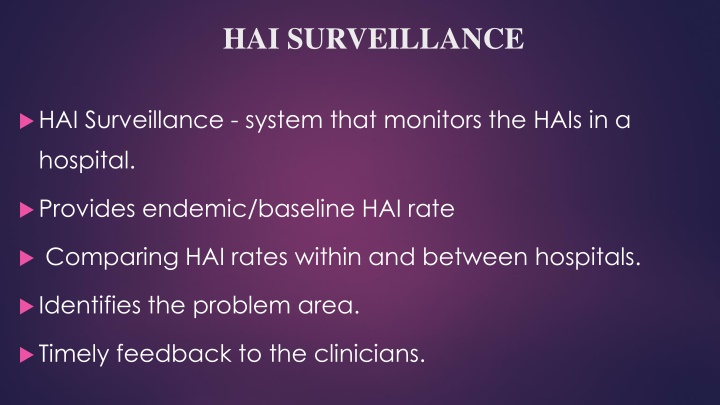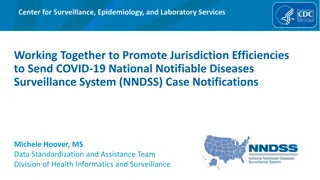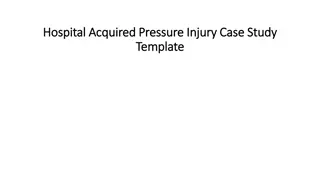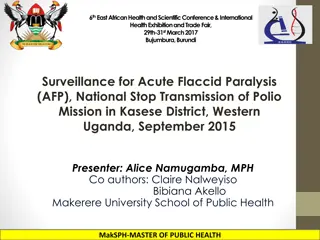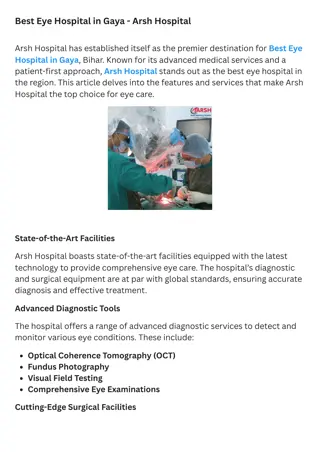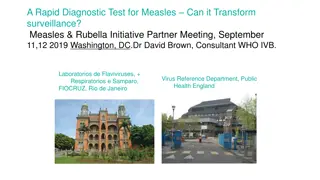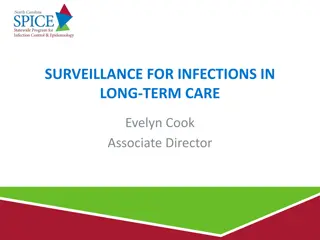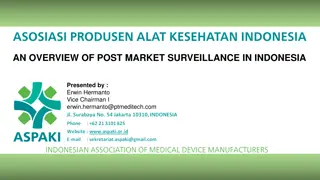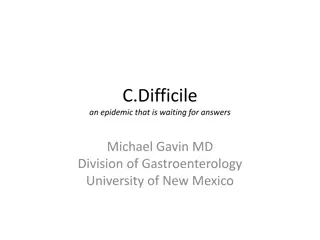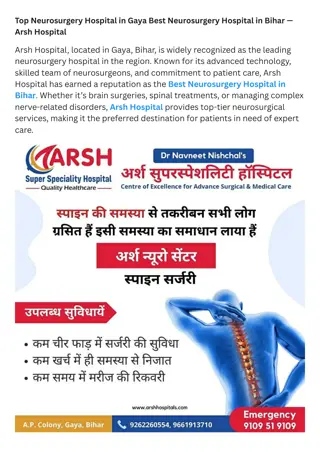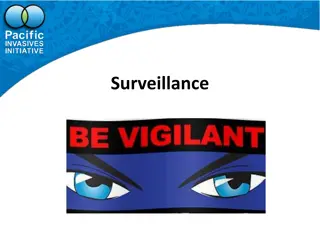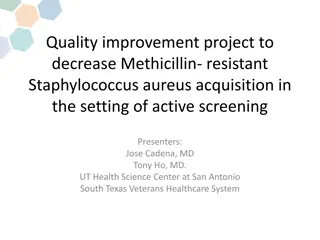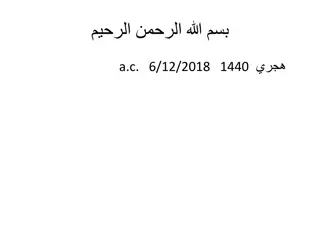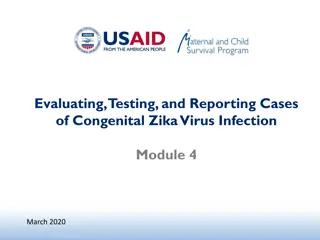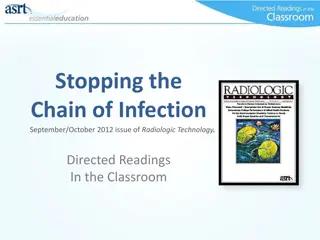Comprehensive Overview of Hospital-Acquired Infection Surveillance System
Surveillance systems like HAI surveillance play a crucial role in monitoring and managing hospital-acquired infections (HAIs) by providing baseline rates, comparing data, and identifying problem areas. This system covers various types of infections such as CAUTI, CLABSI, VAE, and SSI, with specific diagnostic criteria for each. The method of conducting HAI surveillance involves data collection, analysis, interpretation, and dissemination of findings. Each type of infection has specific criteria for diagnosis and classification, enabling healthcare facilities to track and address these infections effectively.
Download Presentation

Please find below an Image/Link to download the presentation.
The content on the website is provided AS IS for your information and personal use only. It may not be sold, licensed, or shared on other websites without obtaining consent from the author.If you encounter any issues during the download, it is possible that the publisher has removed the file from their server.
You are allowed to download the files provided on this website for personal or commercial use, subject to the condition that they are used lawfully. All files are the property of their respective owners.
The content on the website is provided AS IS for your information and personal use only. It may not be sold, licensed, or shared on other websites without obtaining consent from the author.
E N D
Presentation Transcript
HAI SURVEILLANCE HAI Surveillance - system that monitors the HAIs in a hospital. Provides endemic/baseline HAI rate Comparing HAI rates within and between hospitals. Identifies the problem area. Timely feedback to the clinicians.
Hospital-acquired infection surveillance HAIs for which surveillance is conducted: Catheter-associated urinary tract infection (CAUTI) Central line-associated blood stream infection (CLABSI) Ventilator-associated event (VAE) Surgical site infection (SSI). ICNs under the supervision of the officer in-charge of HICC conduct HAI surveillance. HAI surveillance diagnostic criteria: very objective
Method of conducting hai surveillance Data collection Data analysis Data interpretation Data dissemination
CA-UTI Device criteria Presence of a urinary catheter for > 2 days. Clinical criteria Presence of any one symptom of UTI such as fever, suprapubic tenderness, urgency, frequency or dysuria. Culture criteria Isolation of significant count ( 105/mL) of a UTI pathogen from urine.
CLABSI Age Blood culture criteria Organism isolated LCBI pathogen1 LCBI commensal2 Clinical criteria LCBI- laboratory confirmed blood stream infection 1LCBI pathogen- e.g. common hospital acquired pathogens 2LCBI commensal- e.g. Coagulase negative staphylococci 3LCBI-2 symptoms- fever, chills, hypotension 4LCBI-3 symptoms- fever, hypothermia, bradycardia, apnea No. of cultures positives 1 LCBI-1 Any age Symptoms not required Any symptom3 Any symptom4 LCBI-2 >1 year 2 one LCBI-3 <1 year 2 one Device criteria= catheter present for > two calendar days LCBI plus catheter criteria met = called as CLABSI LCBI without catheter criteria met= called as non-CLABSI
VAE (Ventilator associated events) Stage-1: VAC (ventilator associated condition) Device criteria Presence of a mechanical ventilator at least for two calendar 2 days. Oxygenation criteria Baseline period during which the daily minimum FiO2 (fraction of inspired oxygen) and PEEP (positive end- expiratory pressure) values are stable or decreasing for 2 days followed by Period of worsening of oxygenation- increased FiO2 (by 20%) or PEEP ( 3 cm water) for at least 2 days
VAE (Ventilator associated events) Stage-2: IVAC (infection related ventilator associated complications) Clinical criteria Any one out of four- Fever or hypothermia Leucocytosis or leukopenia Antibiotic criteria New antimicrobial agent started and continued for 4 days
VAE (Ventilator associated events) Stage-3: PVAP (Possible ventilator associated pneumonia) Culture criteria Isolation of significant count of a pneumonia pathogen from respiratory specimens such as tracheal aspirate, bronchoalveolar lavage etc.
Surgical site infection (SSI) Definition Surgical site infections (SSI) are defined as infections that develop at the surgical site within 30 days of surgery (within 90 days for breast, cardiac and joint surgeries).
Surgical site infection (SSI) Type of SSIs SSIs are classified based on level where infection developed. Superficial SSI- develops at the level of superficial incisional site (skin and subcutaneous level) within 30 days regardless of type of surgery. Deep SSI- develops at the level of deep incisional site (muscle and fascial level) within 30 days for all surgeries except breast, cardiac and implant surgeries ( 90 days) Organ space SSI- develops at the level of organ space site within 30 days for all surgeries except breast, cardiac and implant surgeries (90 days).
Surgical site infection (SSI) Contd.. One among the following must be met: Clinical (i) presence of purulent pus from the corresponding level of criteria surgical site or (ii) presence of local signs of infections (pain/tenderness, swelling, erythema, heat etc). Positive culture from the discharge collected at the Culture criteria Other corresponding level of surgical site. (i)For superficial SSI- Surgeon s diagnosis is taken as diagnostic evidence criteria (ii)For deep or organ space SSI- histopathological, imaging or gross anatomical evidence of abscess should be present.
Formulae of HAI Infection Rates HAI infection rates Formulae VAE Rate No. of VAE cases/ total no. of ventilator days X 1000 No. of CLABSI cases/ total no. of central line days X 1000 No. of CA-UTI cases/ total no. of catheter days X 1000 No. of SSI/ No. of surgeries done X 100 CLABSI Rate CA-UTI Rate SSI Rate
Prevention of device-associated infections (DAIs) Bundle care approach o Bundle care comprises of 3 to 5 evidence-based elements with strong clinician agreement. o Each of the component must be followed during the insertion or maintenance of the device o Compliance to the bundle care is calculated as all or-none way, i.e. failure of compliance to any of the component leads to non-compliance to the whole bundle
Insertion bundle Inserted appropriate present 2. Sterile items 3. Non-touch technique Maintenance bundle 1. Daily catheter care 1. only indication when is 2. Properly secured 3. Drainage bag must be above the floor and below the bladder level. 4. Closed drainage system 5. HH and change of gloves between patients; separate jug for each bag, alcohol swabs for outlet while emptying urine 6. Daily assessment of readiness of removal 4. Closed drainage system 5. Appropriate size catheter 6. Secured after placement
Bundle care for central line Insertion bundle Maintenance bundle 1.Hand hygiene 2. Sterile PPE 1.Daily aseptic CL care during handling Hand hygiene Alcohol hub decontamination 2.Daily documentation of local sign of infection 3.Change of dressing Chlorhexidine 4.Daily assessment of readiness of removal 3. Site of insertion- Subclavian preferred, avoid femoral 4. Chlorhexidine skin preparation with 2% 5. Skin must be completely dry after use of antiseptics 6.Use semi permeable dressing 7.Hand wash after procedure 8.Document data and time of insertion
Maintenance bundle for ventilator care Maintenance bundle Adherence to hand hygiene Elevation of the head of the bed to 30-450 Daily oral care with chlorhexidine 2% solution Need of PUD (peptic ulcer disease) prophylaxis to be assessed daily; if needed only sucralfate should be used. DVT (deep vein thrombosis) prophylaxis should be provided if needed. Daily assessment of readiness to removal of MV
Prevention of SSI Preoperative measures 1. Preoperative bathing 2. For MRSA nasal carriers: Decolonization with mupirocin ointment 3.Hair removal: strongly discouraged, If needed should be removed only with a clipper. 4. Pre-operative oral antibiotics combined with mechanical bowel preparation (MBP) - elective colorectal surgery.
Prevention of SSI Intra-operative measures 1.Surgical antimicrobial prophylaxis (SAP) must be provided for all except clean surgeries. Administered within 60-120 minutes before incision Choice- depends upon local antibiotic policy. Cefazolin or cefuroxime are the usual agent of choice. Frequency- SAP is usually given as single dose. Repeat dose may be required only for: duration >4 hr, cardiac surgeries, drugs with lower half-lives, extensive blood loss during surgery 2. Surgical hand disinfection 3. Surgical site preparation should be performed with alcohol-based chlorhexidine antiseptic solution. 4. Perioperative maintenance of oxygenation, temperature, blood glucose level, circulating volume and nutritional support during surgery and immediate 4-6hr
Prevention of SSI Post -operative measures 1. Daily wound dressing 2. OT disinfection - with a high level disinfectant, in between cases and after the last case (terminal disinfection). 3. Periodic monitoring the air quality of OT for various parameters such as no. of air exchanges, temperature, humidity, pressure and microbial contamination. 4. SAP prolongation is not recommended.
References Textbook of Medical Microbiology by Ananthnarayan, Paniker Textbook of Medical Microbiology by Satish Gupte Textbook of Medical Microbiology by S. Bhat, A.S.Sastry Textbook of Medical Microbiology by D.R.Arora, Brij bala Arora
